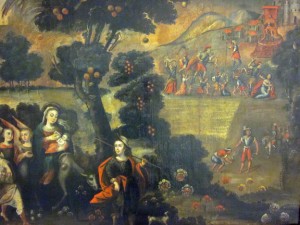 On Mother’s Day in 2014, the New Mexico History Museum plans to unveil a new exhibition, Painting the Divine: Images of Mary in the New World, featuring about 35 paintings from the museum’s Collier Collection. Most of them have been held in storage for a long time and, when they emerge, they’ll provide visitors with a glimpse of the earliest religious art created by artists in Mexico and South America. As part of the planning for the exhibition, the museum asked contract conservator Cynthia Lawrence to get up close and personal with a few of the paintings, which she did today.
On Mother’s Day in 2014, the New Mexico History Museum plans to unveil a new exhibition, Painting the Divine: Images of Mary in the New World, featuring about 35 paintings from the museum’s Collier Collection. Most of them have been held in storage for a long time and, when they emerge, they’ll provide visitors with a glimpse of the earliest religious art created by artists in Mexico and South America. As part of the planning for the exhibition, the museum asked contract conservator Cynthia Lawrence to get up close and personal with a few of the paintings, which she did today.
Most of the staff has never seen the paintings before, and we couldn’t help taking a peek and passing it along to you.
The reason they were pulled from storage was to help us get an idea of what kind of shape the paintings are in and, from that, figure out how many we can afford to give facelifts to. As a first step, Cynthia tested a variety of solvents on small sections of each painting to see what it would take to remove discolored varnish and years of dirt, soot and grime.
“Water is a solvent,” she said, “alcohols and petroleum distillates, and all kinds of thing with different properties are what we use.” Above is a portion of Flight from the Desert, painted by an unknown artist in Cuzco, Peru, in the 18th century. Cynthia worked on a portion of the halo area above Mary’s head with the solvents and also analyzed the chemical composition of areas where it looks as though an earlier restoration effort was made.
 “The number-one goal is to preserve the paintings as close to the artist’s original intent as possible, but accepting that there are natural aging things,” Cynthia said. “We don’t want to make them look brand-new.”
“The number-one goal is to preserve the paintings as close to the artist’s original intent as possible, but accepting that there are natural aging things,” Cynthia said. “We don’t want to make them look brand-new.”
At left, she experiments with a solvent on Our Lady of Bethlehem, also painted by an unknown artist in Cuzco, Peru, in the 18th century.
“Spanish colonial paintings in general tend to be in a little bit poorer condition than European paintings,” she said. “That might relate to climate but also probably because they didn’t have the same kind of trained restorers in centuries past. We tend to see not nearly as good a condition. They’ve hung in churches, which are public spaces. Sometimes well-intentioned cleaning people tried to clean them up who weren’t trained restorers.
“These particular ones I’d say are in average condition for what we’d see of this age. There are cracks in the paint. There are places where the paint has flaked away.”
Josef Diaz, the museum’s curator of Southwest and Mexican Colonial Collections, pointed to Massacre of the Innocents for an example of how European religious art began morphing into new cultures. Here’s how the painting looks in general (forgive the point-and-shoot photography and laboratory lighting):
Look at the bottom right-hand side and you can see that the painting’s unknown artist in 18th-century Peru, has cast the wheat-threshers as Native peoples instead of the Romans you see elsewhere in the painting. Here’s a close-up:
Once Painting the Divine comes together, more of those sorts of discoveries will come to light — along with, we hope, some of the more brilliant colors lying wait beneath the varnish and grime that Lawrence is providing a first assessment of.
“These pieces help put our own collection of New Mexican retablos and bultos into the larger world of Spanish colonial painting,” Josef said. “Many of them served as examples for the santeros and inspired the pieces that were later created in New Mexico.”



Pingback: NM History Museum News Blog » Blog Archive » Unlocking the Secrets of a 19th-Century Painting